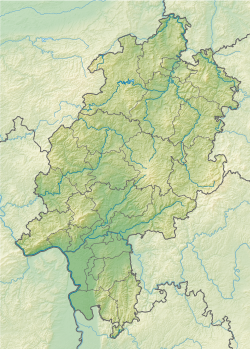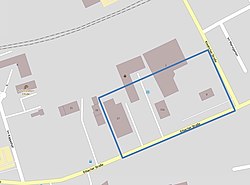Eltville burial ground
Coordinates: 50 ° 1 ′ 24.8 ″ N , 8 ° 6 ′ 46.2 ″ E
| Eltville burial ground on the Rhine | ||
|---|---|---|
|
Eltville burial ground. Aerial photo from 1953 |
||
| location | Hessen , Germany | |
| Location | Eltville on the Rhine | |
|
|
||
| When | Middle of the 5th century - beginning of the 8th century | |
| Where | Eltville am Rhein , Rheingau-Taunus-Kreis / Hessen | |
|
Find area |
||
The early medieval burial ground of Eltville in Eltville am Rhein is a predominantly Merovingian burial ground from the middle of the 5th century to the beginning of the 8th century. In the course of various excavations, 594 graves with a total of 645 burials were found until 1976. In new excavations in 2015 and 2016, a further 150 graves have been discovered so far (as of June 2016). It is therefore one of the largest sites in the Rhine-Main area .
location and size
The grave field is located on the western outskirts of Eltville on Erbacher Strasse and is now largely built over. The eastern border is formed by the L3035 road to Kiedrich , as no more graves have been found in a larger section parallel to the road. The northern border is approx. 90 m from Erbacher Strasse, and no more finds have been found south of the railway embankment. In 1953, the most westerly excavations took place in the area of Erbacher Strasse 17 (former Schäfer textile factory ); the properties at Erbacher Strasse 19 and 21 were not archaeologically examined due to the overbuilding. In 1984 no more graves were observed during the construction of the road "Im Kappelhof" to the west and the police station. When Erbacher Strasse was expanded in 1964, a few graves were found in the area of the street; there were no more finds south of the street. The explored burial ground thus has an approximate extent in north-south direction of 90 m and in east-west direction of 175 m.
Find description
During excavation work for a machine hall of the Hans Holland company , the cemetery was discovered in 1940 and reported by an employee of the ground monument maintenance, A. Milani, on July 3, 1940. On July 8th, the first planned excavation began by Helmut Schoppa , an employee of the newly founded State Office for Cultural and Historical Soil Antiquities in Wiesbaden with the support of the district monument keeper Georg Ludwig Duchscherer. Various other excavations followed until 1976. After the company buildings of the former Hans Holland companies and the Schäfer textile factory were demolished in 2015, further graves were discovered during renewed excavations.
Digs
- June to November 1940
- June to August 1953 (emergency recovery)
- 1955
- August 1964 (emergency recovery)
- May to June 1968
- April to September 1969
- June / July 1970
- 1973 to 1976 (short-term excavations or emergency salvage during construction)
- 2015 to 2016
Graves
The row graves are mostly simple pits, pits with wooden fixtures (chambers) and a few graves with dry stone walls or stone slabs. Remains of a house of the dead were discovered above a grave. Multiple burials took place in some graves. A total of 189 men's graves, 215 women's graves and 230 graves that could not be determined in more detail were recovered. Some graves did not contain any skeletal remains. In almost all graves, the skeletons were aligned in a west-east direction, with the head in the west. A grave is a horse-dog grave.
Found good
The finds from the early graves suggest that the settlers came from Central Germany (Thuringia), while later finds refer to the west of the Merovingian Empire (northern France / Belgium) and southwest Germany. Various weapons such as spaths , saxes , lances, knives, arrows and shields, as well as spurs, belts, rings, fire steel and stones were found as gifts in the boys' and men's graves . The graves of girls and women contained jewelry such as B. Pearls, earrings, pendants, brooches, arm and finger rings and belts. Other finds were vessels made of clay, glass, bronze and wood, as well as spoons, combs, scissors and coins.
The finds found their way into the collection of Nassau antiquities in the Museum Wiesbaden , but after 1990/91 there were exchanges and losses of finds from at least 168 graves. The Nassau antiquities collection was ceded to the city of Wiesbaden in 2009. The skeletons were examined at the Anthropological Institute of the University of Mainz .
literature
- Markus C. Blaich : The early medieval burial ground of Eltville, Rheingau-Taunus-Kreis. Contributions to the settlement history of the Rheingau from the 5th to the 8th century AD. Part 1. Habelt, Bonn 2006. ISBN 3-7749-3332-4
- Sylvia Mitschke: For the recording and evaluation of archaeological textiles on corroded metal: a study of selected finds from the Eltville burial ground, Rheingau-Taunus-Kreis (5th-8th centuries AD) Digital copies of the edition: Marburg / Lahn, 2001 Location: University of Marburg, Department of Pre- a. Early history (411)
Individual evidence
- ↑ http://www.rheingau.de/artikel/details/9936 ( Memento from June 10, 2016 in the Internet Archive )


